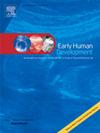Impact of chorionicity and histological chorioamnionitis on neurodevelopment and mortality in extremely preterm twins
IF 2
3区 医学
Q2 OBSTETRICS & GYNECOLOGY
引用次数: 0
Abstract
Background
Histological chorioamnionitis (HCAM) is associated with adverse neurodevelopmental outcomes; however, its role in extremely preterm twin pregnancies (<28 weeks of gestation), particularly in relation to chorionicity, is unclear.
Objective
To evaluate the association between HCAM severity and neurodevelopmental outcomes at 3 years old in extremely preterm twins, focusing on the modifying effect of chorionicity.
Methods
Utilizing data from the Neonatal Research Network of Japan (2004–2020), this retrospective cohort study included twins born at <28 weeks' gestation and birth weight < 1500 g. HCAM severity was classified based on Blanc's criteria. Primary outcomes were cerebral palsy (CP) and developmental quotient (DQ) < 70 at 3 years old, assessed using the Kyoto Scale of Psychological Development. Secondary outcomes included death before neonatal intensive care unit (NICU) discharge and a composite outcome of death, including CP or DQ < 70. Multivariate logistic regression was performed adjusting for confounders and including interaction terms.
Results
Among 1249 infants, HCAM severity was not significantly associated with CP or DQ < 70 in monochorionic diamniotic (MD) or dichorionic diamniotic (DD) twins. MD twins exhibited a significantly higher mortality risk than DD twins (adjusted odds ratio: 1.73; 95 % confidence intervals: 1.22–2.46). Moreover, significant interaction between HCAM and chorionicity was not observed for mortality.
Conclusion
In this large, multicenter cohort of extremely preterm twins, HCAM was not associated with adverse neurodevelopmental outcomes or early mortality. However, monochorionic status was independently associated with increased NICU mortality, highlighting the predominant role of chorionicity in twin pregnancy–related outcomes.
绒毛膜性和组织学绒毛膜羊膜炎对极早产儿神经发育和死亡率的影响
组织学绒毛膜羊膜炎(HCAM)与不良的神经发育结局相关;然而,其在极早产双胎妊娠(妊娠28周)中的作用,特别是与绒毛膜性的关系尚不清楚。目的探讨3岁极早产儿HCAM严重程度与神经发育结局的关系,重点探讨绒毛膜性的调节作用。方法利用日本新生儿研究网络(2004-2020)的数据,本回顾性队列研究纳入了妊娠28周出生、出生体重1500 g的双胞胎。HCAM的严重程度根据Blanc的标准进行分类。主要结局是3岁时脑瘫(CP)和发育商(DQ) 70,采用京都心理发展量表进行评估。次要结局包括新生儿重症监护病房(NICU)出院前死亡和死亡的综合结局,包括CP或DQ <; 70。进行多变量逻辑回归,调整混杂因素并包括相互作用项。结果在1249例婴儿中,单绒毛膜双胎(MD)和双绒毛膜双胎(DD)双胞胎中,HCAM严重程度与CP或DQ [lt; 70]无显著相关性。MD双胞胎的死亡风险明显高于DD双胞胎(校正优势比:1.73;95%置信区间:1.22-2.46)。此外,没有观察到HCAM和绒毛膜性之间的显著相互作用。结论:在这个大型、多中心的极早产双胞胎队列中,HCAM与不良的神经发育结局或早期死亡无关。然而,单绒毛膜状态与新生儿重症监护病房死亡率增加独立相关,强调了绒毛膜在双胎妊娠相关结局中的主要作用。
本文章由计算机程序翻译,如有差异,请以英文原文为准。
求助全文
约1分钟内获得全文
求助全文
来源期刊

Early human development
医学-妇产科学
CiteScore
4.40
自引率
4.00%
发文量
100
审稿时长
46 days
期刊介绍:
Established as an authoritative, highly cited voice on early human development, Early Human Development provides a unique opportunity for researchers and clinicians to bridge the communication gap between disciplines. Creating a forum for the productive exchange of ideas concerning early human growth and development, the journal publishes original research and clinical papers with particular emphasis on the continuum between fetal life and the perinatal period; aspects of postnatal growth influenced by early events; and the safeguarding of the quality of human survival.
The first comprehensive and interdisciplinary journal in this area of growing importance, Early Human Development offers pertinent contributions to the following subject areas:
Fetology; perinatology; pediatrics; growth and development; obstetrics; reproduction and fertility; epidemiology; behavioural sciences; nutrition and metabolism; teratology; neurology; brain biology; developmental psychology and screening.
 求助内容:
求助内容: 应助结果提醒方式:
应助结果提醒方式:


